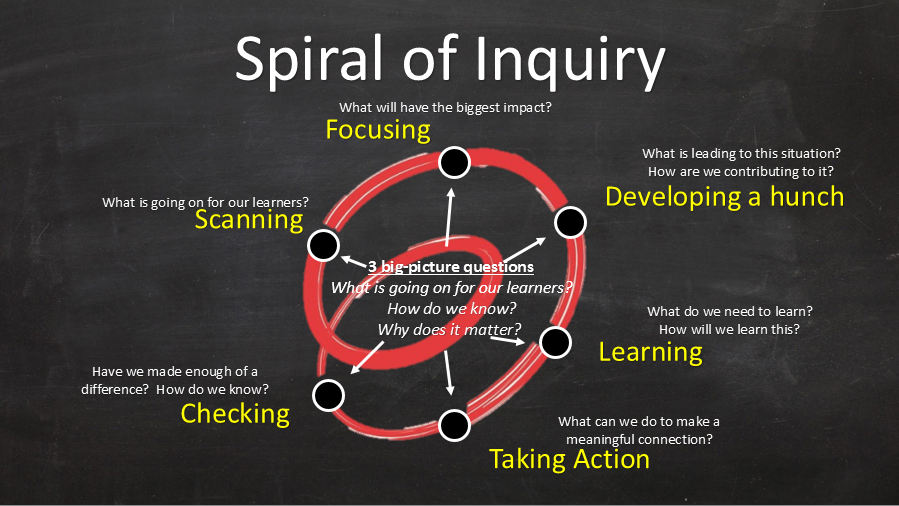I have always been drawn to the spiral of inquiry because it has so many different components and being able to work through a process little by little is less intimidating for me than having to work through larger processes all at once. As defined by teacher magazine, the spiral of inquiry is “a systematic process for investigating and improving learner outcomes; academic, social and wellbeing.” (2019) This inquiry really appeals to me because it does not just focus on academic outcomes but considers a more holistic view which aligns with Gretchen’s class content. I have trouble seeing the use in doing something if it does not make me a better person, learner or teacher and because I can make helpful connections to other courses regarding spiral of inquiry… it is something I am interested in researching to better myself.
I am very much a list person and need lists for everything. Since this inquiry approach aligns the most with my daily life it is a perfect fit for me to consider this approach the one, I will continue to bring with me during my education journey. It is natural for me to complete something and then reflect before moving forward and this approach has the ability to do that embedded in it.
Spiral of Inquiry (as seen in the photo below) consists of six stages — scanning; focusing; developing hunches; learning; taking action; and, checking. These stages are all interconnected and rely on each other but at the same time, these stages take place separately and when the stages are broken up it is easier to learn and understand. This inquiry process flows easily and for better understanding I look at it as a design process with built in breaks to reflect if this process is right for the learner and if it is time to move onto the next stage or not, reflection is key. There are three big questions that you ask yourself at every stage, 1) What is going on for our learners, 2) How do we know, and 3) Why does this matter? Not only is this inquiry broken down into stages it has built in guidance questions to help move you along. This is what is appealing to me about this inquiry and also it gives so much opportunity to integrate the First Peoples Principles of Learning into it.
My inquiry question from Block 1 was “how do I use formative assessment during a lesson and how does that information then guide my lesson planning? Furthermore, what difference does descriptive or formative feedback make regarding students’ performance?” During my first practicum I was able to have some experience with formative assessment and how I had to take that assessment and alter my lesson plans according to what I found out the students needed, either individually or as a group. This meant completely pivoting and throwing away lessons I thought would be suitable for the next day and starting over so I could teach the students the things they needed to know before scaffolding them into the next materials.
Although my inquiry question from block 1 is still valid and I believe I have much more learning to do about assessment, since being in a classroom my question has grown.
“How can I facilitate student’s independence while also building a self-motivated learning community within my classroom and how can this positive learning community foster a passion for learning beyond the formative years?”
This new inquiry question comes from the high number of disengaged learners that I taught in my first practicum. I will use my remaining practicums to inquire about this new question as I gather more experience being a teacher.

Earp, J. (2019, November 18). Q&A: Spiral of inquiry. Teacher Magazine. https://www.teachermagazine.com/au_en/articles/qa-spiral-of-inquiry.